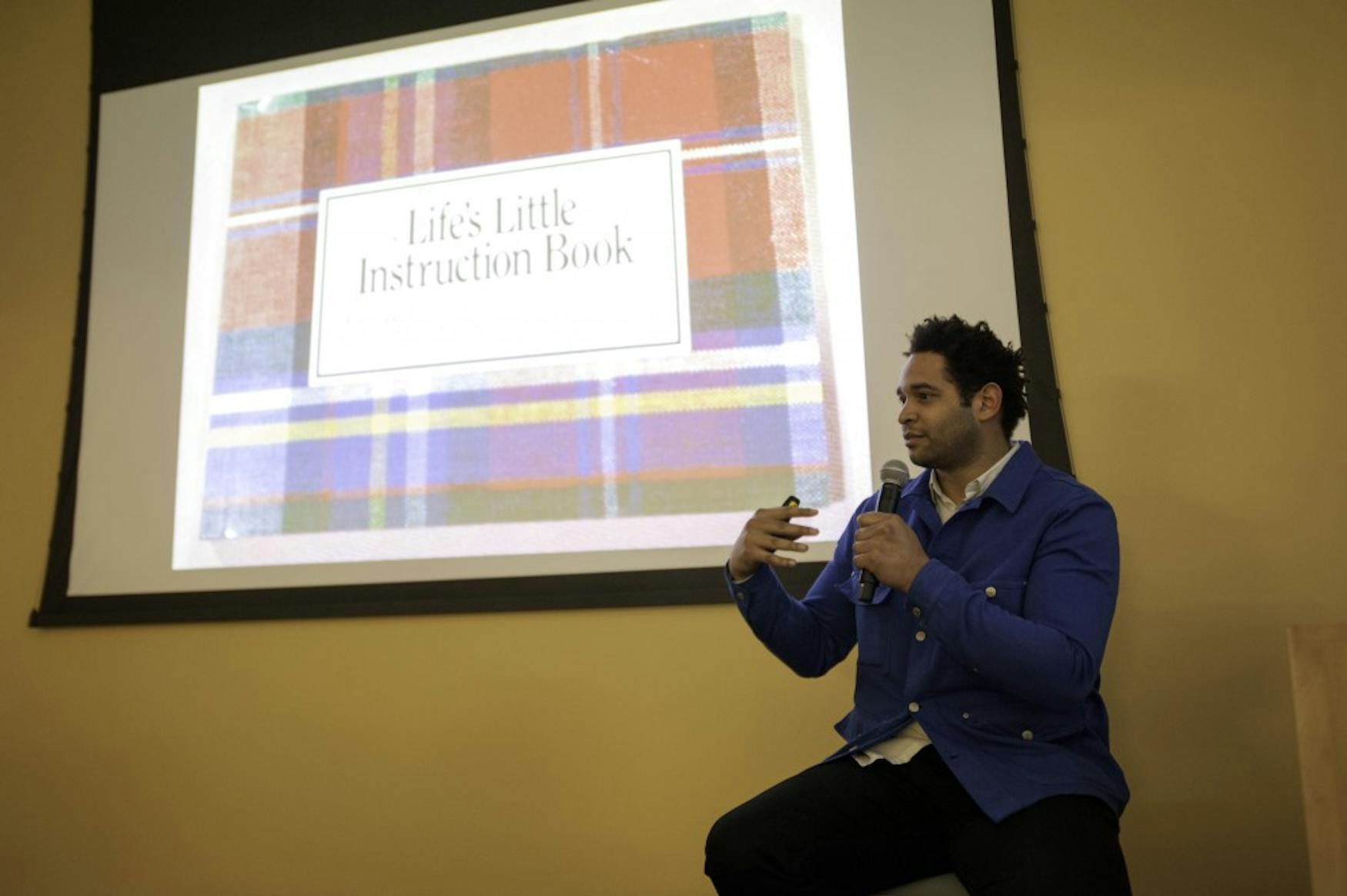Tony Lewis recounts his evolution as an artist and his exploration of creating drawings
In discussing the evolution of his career as an artist in a talk on Thursday night, Tony Lewis, the 2017-18 Ruth Ann and Nathan Perlmutter artist-in-residence, brought audiences with him on a journey of finding his artistic style, culminating in “Plunder,” a work that he created at and for the Rose Art Museum at Brandeis.
In October, with the help of Brandeis students, Lewis created “Plunder,” a large art installation on the outward-facing wall of the Rose Art Museum’s Lois Foster Wing. The artwork is made of graphite powder-dipped rubber bands stretched between nails in the wall, layered in a web to create a solid black mass in the shape of the Gregg shorthand notation for the word “plunder.”
“Three things—drawing, language, and graphite—ends up being this thing that I constantly am thinking about,” Lewis told the audience.
He guided his audience through his development as an artist, starting with his days as an art student when he first experimented with graphite powder.
“I basically took the graphite powder … and I dumped it out on the floor. At first by accident,” Lewis admitted, adding, “The second time I did it was on purpose.”
Lewis recounted how he changed the way he saw the spilled graphite powder, initially fearing that it would smudge the “pristine” drawings he had created. When the drawings inevitably got smudged, Lewis started to panic.
“And then after a while, I kind of let go, and I said, ‘Screw it, I don’t care if these things get dirty.’ And then they got really dirty,” Lewis said, explaining that he “let go of a bunch of anxiety” and “succumbed to the issue of powder.”
Lewis showed the audience photos of his old studio, with piles of graphite dust on the floor and graphite powder smudging the walls. He also shared photos of some of his first experiments with rubber bands and pushpins, explaining that he started using these objects because they were lying around the studio (he used pushpins to hang drawings, and the paper he drew on came bound in rubber bands).
“It is possible that I bought a rubber band ball because it was next to the pushpins in Staples,” Lewis acknowledged, highlighting the somewhat accidental, natural progression of combining these simple objects in his artwork.
He presented an image of a splatter of graphite powder on the wall, describing how he had picked up rubber bands that were coated in graphite powder from falling on the floor and flicked them at the wall. “I was going nuts because it was … a chance to make the fastest drawing possible,” Lewis said.
Ironically, despite his joy at these fast drawings, Lewis would go on to make time-consuming and labor-intensive works out of these same basic materials.
Lewis oriented much of his talk around a small book called Life’s Little Instruction Book, a collection of short pieces of advice that he found in his mother’s bathroom. He displayed a collection of works similar to “Plunder” made with graphite-dipped rubber bands stretched between nails and spelling out quotes from the book in a large font across museum walls.
“Usually something that is pretty infuriating or pretty funny is enough for me to want to make it,” Lewis said, reflecting on why he was drawn to using the quotes in his artwork.
Some quotes that Lewis recreated include “9. Say ‘please’ a lot,” “362. Know when to keep silent,” “26. If in a fight, hit first and hit hard,” “366. Don’t flush urinals with your hand—use your elbow” and “112. Never argue with police officers, and address them as ‘officer.’”
When he started creating the quote installations, Lewis only outlined the letters with the rubber bands, but as he continued to work with the subject matter, he started filling the letters in completely with graphite-covered rubber bands. He likened this technique to “very intense crosshatching,” emphasizing the fact that despite the scale and labor intensity of his works, he still sees them as drawings.
After making a series of these drawings, Lewis realized that recreating quotes was only giving him “one relationship to language,” and that he wanted “a different relationship to language, one a little more free … one that was less based in somebody else’s words.”
Finding a dictionary of shorthand notation in a thrift store offered Lewis the opportunity to form a new relationship with language. He began to make colored pencil and graphite drawings of large blocks of color obscuring the abstract shapes of Gregg shorthand.
Shorthand allowed Lewis “to keep the foundation of language as a principle for making a drawing” and to “keep that sort of diagrammatic, systematic way of approaching making a drawing,” he explained, but also allowed him “to not care at all … about what it looked like.”
Having developed his technique of rubber band crosshatching, experimented with large-scale text installations and discovered Gregg shorthand as a new way to work language into his artwork, Lewis finally had the tools necessary for creating “Plunder.”
Describing the relationship between his techniques and “more traditional ways we think about drawing,” Lewis said his work is “still rooted in … the most colloquial way we think about drawing, which is pencil and paper, but basically understanding pencil and paper as something that can … exist in a way that … blows up those ideas.”
—Editor’s note: Jocelyn Gould is a member of the Student Committee for the Rose Art Museum.



Please note All comments are eligible for publication in The Justice.